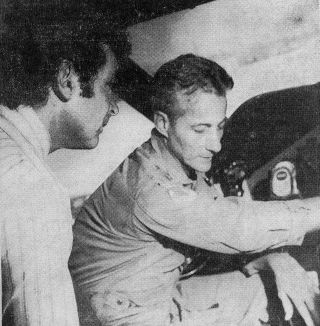T-Tail-Tall-Tail:
If Lost, Hail A StarLifter
By TSgt. C. NENNIG
This article appeared in the
NORTON AFB GLOBETROTTER newspaper
on 7/31/1970.
Sumbitted by Barry Geier from his personal
collection.
Two extra gallons of fuel and a Military Airlift
Command C-141 StarLifter
made the difference recently between crashing and
landing safely for a Los
Angeles light plane pilot and his three passengers.
THE FIRST time that Rick Ray, Hollywood business
agent for writers in the
entertainment field, and Capt. William R. Bowman,
instructor pilot and
full-time Air Reserve technician with the 944th
Military Airlift Group (Assoc.)
(Res.), met was at 10,000 feet over southern
Arizona.
Capt. Bowman Shows Rick Ray C-141 Starlifter
Piloting a 63rd Military Airlift Wing C-141 on a
"Kelly turn around"
mission, Captain Bowman was at 35,000 feet near
Tucson, Ariz., when the word
was flashed that Ray was lost in a Mooney 21
aircraft somewhere near the
Mexican border. Albuquerque FAA Center, N.M., and
Tucson Approach Control
requested assistance of the MAC crew and aircraft in
locating him.
STARTING LATE, the flight of the single-engine Mooney
originated from Van
Nuys Airport, Calif., bound for Tucson. Part of the
delay was occasioned by
Ray's caution in seeing that the fuel tanks were
filled to the brim, though the
topping off took only two gallons. Things progressed
satisfactorily, once
airborne, until he passed Yuma, Ariz. and was
nearing Gila Bend. A line of
thunderstorms blocked his course at the point,
however, he was informed by
radio from Albuquerque air traffic control that he
could avoid them by
detouring south southeast.
UNDERSTANDING the controller to say a heading of 120
degrees would take him
to Tucson, he set his course accordingly but saw
only dark desert below. He
couldn't reach air traffic control again and neither
his automatic direction
finder nor VOR navigational radio worked.
Turning his transmitter to emergency frequency, Ray
called to anyone who
might hear him that he was lost and running low on
fuel. A CONTINENTAL Airlines
captain talking to Albuquerque heard his
predicament, contacted him, then
relayed the information to the center. Before the
night was over, Ray talked
with pilots flying Western and American Airlines
jets as well as Albuquerque
and Tucson, but was never in voice contact with
Bowman in the C-141.
Luckily he was within radar range of Tucson approach
control and through the
radio relays, he was given a northerly heading
drastically changing his fligh
direction. However, Tucson could not at this point
verify the blip on their
radar as Ray.
AT THIS MOMENT, Captain Bowman and his crew entered
the situation in the
Starlifter while cruising s 35,000 feet 40 miles
north c Tucson enroute from
Kell AFB, Tex., to Norton. Receiving the request
from the Albuquerque Center
for assistance in locating the lost aircraft, Bowman
diverted to the south and
descended as rapidly as possible to 10,000. Captain
Bowman then turned on all
the aircraft's landing, taxiing, inspection and
navigation lights.
BY THIS TIME, both Ray's wing tanks were registering
zero on the gauges,
and, although on course for Tucson, he couldn't see
it. "For 15 minutes, I
contemplated eternity and waited for the engine to
quit," he said. But time was
with the faltering Mooney, it took the MAC crew only
about 12 minutes to find
the craft some 50 miles southwest of Tucson near the
Mexican border.
"AS IT WENT whizzing by me in a blaze of light on
that initial pass," Ray
said, "I had a momentary qualm of terror then a
tremendous feeling of moral
support. It looked just like a city of lights with
wings."
Since Ray was cruising at a bare 90 knots to conserve
fuel, the C-141, with
flaps down and throttled back as much as safely
possible, couldn't fly slow
enough to stay with him and shot by on each pass.
WITH THE MOONEY in a imminent crash position, Captain
Bowman circled back as
quickly as the StarLifter could come about and
confirmed Ray's direction of
flight for Tucson as correct. Moments later, the
runway lights of Ryan Field, a
small private strip 10 miles west of Tucson popped
up, and the Mooney dropped
down from 8,000 feet for a rough but safe landing.
The Norton aircraft then
returned to its original course.
Last week Ray visited Norton to say "thank you" to
Captain Bowman and get a
closer look on the ground and a tour through "the
big bird" that saved him and
his friends. During the course of luncheon, he
learned some of Captain Bowman's
interesting background, such as two MIG kills in
F-86 Sabres during the Korean
War, experiences as a rescue crew commander on an
HC-130H, Hercules and flying
F4C Phantoms during a recent combat tour in the
Republic of Vietman.
BUT WHEN all the hanger flying was done over the
luncheon table, Ray capped
the whole thing with an observation concerning the
aftermath of his harrowing
experience that night south of Tucson. When the
52-gallon left wing tank was
filled the next morning, it took 51. Those precious
two gallons, in topping off
at Van Nuys, saved four lives.
